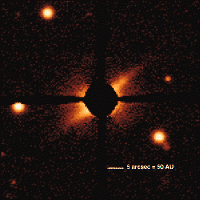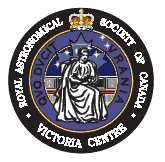September 14, 2005 - A Long and Grinding Road: The Phenomenon of Debris
Disks around Main Sequence Stars - Dr. Brenda Matthews, NRC-HIA
Abstract:
 During
the last phases of a star's formation, remnant solid material may
agglomerate to form planetesimals in orbit within a disk around the
parent star. Over time, due to forces of drag or the formation of large
bodies (planets!), the planetesimals undergo collisions, returning
them from larger bodies back to their previous micron scales of cosmic dust.
These dusty "debris" disks are once again observable because the small dust
grains both emit radiation at submillimetre wavelengths and scatter optical
and infrared light from the star.
During
the last phases of a star's formation, remnant solid material may
agglomerate to form planetesimals in orbit within a disk around the
parent star. Over time, due to forces of drag or the formation of large
bodies (planets!), the planetesimals undergo collisions, returning
them from larger bodies back to their previous micron scales of cosmic dust.
These dusty "debris" disks are once again observable because the small dust
grains both emit radiation at submillimetre wavelengths and scatter optical
and infrared light from the star.
Discovered unexpectedly in 1983 around Vega, debris disks are now sought
using telescopes over a large range of wavelength; the presence of a debris
disk can be a harbinger of planet formation around very young stars. I will
present a history of this young research field, including images of disks
detected around the lowest mass stars and optical images from the Hubble
Telescope.
02.26.2004 - Astronomers find nearest and youngest star with
a dusty debris disk. But are there planets
Bio

